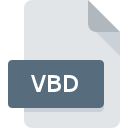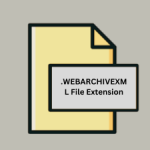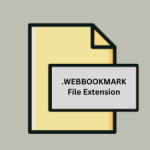.VBD File Extension

What is an VBD file?
The .VBD file extension stands for Visual Basic ActiveX Document. This file format is associated with Microsoft’s Visual Basic, a programming language and integrated development environment (IDE) used for creating Windows applications.
Specifically, the .VBD file type pertains to ActiveX documents within the Visual Basic framework, used to create web-based or desktop applications that can leverage ActiveX technology.
ActiveX is a set of technologies developed by Microsoft that enables interactive content and functionality within applications.
Visual Basic ActiveX documents are often used in scenarios where developers need to embed a Visual Basic application or component within a web page or another application.
More Information.
The history of the .VBD file format is closely tied to the evolution of Microsoft’s development tools and technologies.
Visual Basic has been a popular language since its initial release in 1991. It allowed developers to create Windows applications with a graphical user interface quickly and efficiently.
The introduction of ActiveX technologies in the late 1990s marked a significant shift in how applications and components were developed and deployed.
ActiveX controls provided a way to embed rich, interactive components into web pages and desktop applications, making it possible for developers to create more dynamic and feature-rich software.
The .VBD file format was designed to facilitate this by packaging Visual Basic applications in a way that could be used with ActiveX controls.
The primary purpose of .VBD files was to support the creation and distribution of these ActiveX-enabled documents.
Developers could use .VBD files to build applications that could be embedded in web pages or other applications, providing a way to leverage the power of Visual Basic and ActiveX technologies together.
Origin Of This File.
The .VBD file extension originated with Microsoft’s Visual Basic 6.0, which was released in 1998. Visual Basic 6.0 introduced support for ActiveX technologies, allowing developers to create and deploy interactive components and documents.
The .VBD files were part of this broader framework, providing a way to package and deploy Visual Basic applications that could be embedded within other applications or web pages using ActiveX controls.
File Structure Technical Specification.
The .VBD file is a proprietary file format developed by Microsoft and is used to store Visual Basic ActiveX documents.
The file structure of a .VBD file is designed to encapsulate the code, resources, and settings necessary for the ActiveX document to function.
Technically, a .VBD file includes several components:
- Code: The Visual Basic code that defines the functionality of the ActiveX document.
- Resources: Various resources such as images, icons, and other assets used by the ActiveX document.
- Settings: Configuration settings that determine how the ActiveX document behaves when deployed.
The .VBD file format is binary, meaning that it is not human-readable and must be interpreted by a compatible application, such as Microsoft Visual Basic or an ActiveX control container.
How to Convert the File?
Converting .VBD files can be challenging due to their proprietary nature and the decline in support for ActiveX technologies. Some approaches can be considered:
- Manual Conversion: If the .VBD file contains essential code or resources, they can be manually extracted and converted into a different format. For instance, Visual Basic code can be adapted into other programming languages or platforms, such as .NET languages.
- Upgrade to Modern Technologies: Developers may need to rewrite or port the functionality of the .VBD file into modern technologies, such as HTML5, JavaScript, or .NET, to ensure compatibility with contemporary systems and browsers.
- Third-Party Tools: There may be specialized tools or services available for converting or migrating Visual Basic and ActiveX components to newer formats. However, finding such tools may be challenging due to the niche nature of .VBD files.
Advantages And Disadvantages.
Advantages:
- Integration with ActiveX: The .VBD file format enables seamless integration with ActiveX controls, allowing developers to create interactive and feature-rich applications.
- Reuse of Visual Basic Code: Developers can leverage existing Visual Basic code and components within ActiveX documents, streamlining development and reducing redundancy.
- Web and Application Embedding: .VBD files can be embedded within web pages and other applications, making it easier to distribute and deploy Visual Basic applications.
Disadvantages:
- Compatibility Issues: As technology has evolved, ActiveX controls and the .VBD file format have become less compatible with modern web standards and operating systems.
- Security Concerns: ActiveX controls have been associated with security vulnerabilities, which can pose risks when used in web pages or applications.
- Limited Support: Support for .VBD files and ActiveX technology has diminished over time, making it challenging to work with these files in contemporary development environments.
How to Open VBD?
Open In Windows
- Visual Basic 6.0: The most straightforward method for opening .VBD files is using Visual Basic 6.0, the environment in which these files were originally created.
- Internet Explorer: Although not recommended due to security concerns, .VBD files may be opened in Internet Explorer, as it supports ActiveX controls.
Open In Linux
- Wine: On Linux, you can use Wine to run Windows applications and potentially open .VBD files if you have Visual Basic 6.0 installed within the Wine environment. However, ActiveX controls may not function correctly due to compatibility issues.
Open In MAC
- Limited Support: Mac OS does not natively support .VBD files or ActiveX controls. To open these files on a Mac, you would need to use a virtual machine or compatibility layer running Windows, such as Parallels or VMware Fusion.













